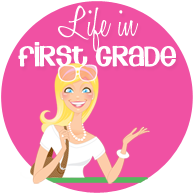Let's talk data. Student Data. This has always been an area that kinda rattles me. I am going to be honest! As a veteran teacher, I truly pride myself on being well versed (is there room for improvement? YES! of course!) in data--gathering data, providing instructional outcomes and assessments in order to get the data I need to drive instruction forward. A mouthful, right?? Then I take that data and put it into MY data binder (have you seen this one from my sweet blogger sis, Leigh,
The Applicious Teacher??). I love this
teacher data binder!
However, in recent years there is something that has always haunted me in my Professional Developmental Plan! Student Driven Data!
*How do your students keep track of their own data?
*How do your students know how they are doing?
*Do your students create rubrics to help in their learning?
These are not the exact words used but you get the gist. What do you mean-- kids have to track their own data?
*Some of them can barely tie their own shoes!
*We are still trying to walk quietly in a line, people!!!
*Some kids are still trying to write on the line!
*There are kids who do not even know my name! (ok, that's an exaggeration! LOL!)
Isn't that my job-- to keep track of data? Did you see my cute binder with all their data stored? So the answer to this question is a serious YES! I always got dinged for this particular area. So I began to look into student data and how my kids could track their own data. What were some assessments that we could easily track and not get overwhelmed where Mrs. Hamlin didn't have to go running for the nearest retail store (I believe in retail therapy!!).
I LOVE Ulta!!! I wanna live there and try on lipgloss all day!
Of course my quest began towards the end of the year when I couldn't really track that much growth but this upcoming school year, I will!
Click on the picture to grab it!
I'm here to give you a brief low down dirty on these things! And as our year goes I will give you more insight, tips, and tricks as we go! I really think it's a learning process since our classes are all different! I'm not gonna lie-- it's a process! Blood, sweat, tears, some choice sailor words, smiles, triumphs, whoop-whoops, and hollers will occur! Hopefully more of the latter! It's a guiding principle that will stay with you ALL YEAR!! Your GOAL is to stick with it!
Step 1: Define What is a GOAL?
To start this process, I started out with my own little cutie! Gabriel is such a willing participant! Sometimes...We have been reading all summer and my one focus for him is fluency and accuracy! He is such a great reader, has super comprehension BUT he lacks focus sometimes. So to start out, I had to set the expectation of what is a GOAL. This is such a crucial step! I always involve literature of sorts into almost ALL of my lessons and one particular book that I've read.
Cliche? Maybe... but in our reading, I always stressed that in the end, all the little engine wanted to do was to get up that hill! That was his GOAL! Once we established that we talked about our goal for reading fluency and how the need to read fluently and accurately will increase our readability, comprehension, and stamina! We discussed that you aren't always going to hit your goal the first time but it's important that you try to get close to it!
Step 2: Let the students set their goals! What do they want to accomplish?
This is important!! Let them take the guiding principal in their learning! Kids know what they know. If they don't (like, the ones who say they live in mansion with a million bathrooms! Yeah, me, too, sweetie! LOL!), well, this is their time to shine or not. The purpose of goal setting is to get as close to the the goal as you possibly can given the tools and strategies taught to you.
Step 3: Administer the Assessment
We have loved using
Tamara's Fluency Packs! It's a must! This is what I used with Gabriel this summer but the assessment piece is all up to you. What are you looking at with your students? What data trends would be most helpful to them and you? What areas of growth do you see or areas of improvement are needed? I've given you tons of kid-friendly graphs to choose from and editable files to make your own. The possibilities are endless!
Step 4: Graph and Reflection
Once they get the assessment back, IMMEDIATE feedback is crucial! In our case, I was able to tell Gabriel his score immediately but in a class of 18 or more that may not always be the case but you'll want to set aside time for them to take a look at their data and graph it and really look at where they are. I'll blog a bit later with the reflection piece and how to guide them in their thinking and how they can put into words how they can improve for next time!
I am really excited about this project and know that it will benefit my students this year! This is a project that is so dear to my heart. I hope to have this posted soon and ready for back to school!
I would love to hear if you do data notebooks in your class and how your class has responded to them!
If you'd like to grab this, click
here!

















































